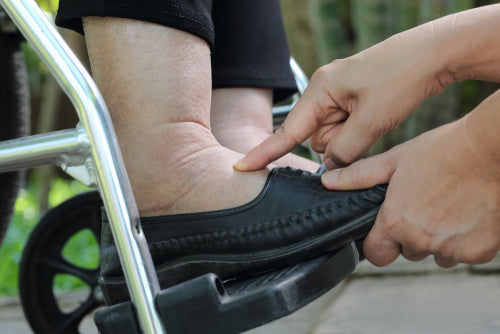Wearing Compression Stockings After Surgery: Everything You Need to Know
If you’ve got a major surgery coming up, especially if that surgery affects your lower leg, your doctor may recommend wearing compression stockings after surgery to help boost your recovery. In fact, graduated compression stockings offer four distinct benefits for post-surgery patients, from reducing swelling to protecting against DVT.
A caveat before we break down these four advantages: No matter how beneficial compression stockings are, you should not wear them after surgery without the explicit instruction of your doctor. If you think you might benefit from wearing compression stockings after surgery, but your doctor hasn’t prescribed them, talk to them before you decide to get yourself some.

1. Promotes Circulation
Your movement may be limited after surgery, so the surgical site can heal. However, just lying around on the bed or the couch is really bad for your circulation since movement makes your heart pump more and stimulates venous blood flow by working your muscles. Graduated compression stockings encourage your blood to keep flowing by applying gentle pressure that tapers up your legs. This pressure encourages venous circulation even when you can’t move, making compression stockings a great solution for post-surgery patients on bed rest.
2. Reduces Swelling
Some level of swelling is common and even expected after surgery. However, extreme swelling is not, and it can hamper your recovery and even lead to complications. Wearing compression stockings after surgery helps reduce swelling because the specially woven fabric does not allow your skin to expand, forcing the fluid to dissipate instead of settling in one place and causing swelling. For best results, compression stockings should be donned before you have a chance to swell very much, usually in the early morning right when you wake up. However, if your doctor instructs you to wear your compression stockings at any other time (such as during sleep), follow their rules first and foremost.

2. Discourages Symptoms of DVT
Deep vein thrombosis (DVT) is a serious condition that occurs when a blood clot forms deep in the veins. Such blood clots usually form in the legs, but they can manifest in other deep veins of the body as well. If the blood clot breaks off and travels, it can cause severe problems in the lungs in the form of a pulmonary embolism. Signs of DVT include pain in your leg, red or discolored skin and a feeling of warmth. Surgery increases your chances of developing DVT, and having to remain sedentary also contributes to your risk -- only walking early on and elevation truly increase venous blood flow but wearing compression socks after surgery can help decrease the risk of developing DVT.

4. Promotes a Safer Recovery
All of these factors combine to make your recovery safer overall. Graduated compression stockings improve circulation and reduce swelling, which helps prevent DVT and spider/varicose veins as well as speed up healing times. Compression stockings are also noninvasive and relatively inexpensive in the scheme of medical treatments, making them a great complement to other treatments.
Recovery from surgery is a long journey, but wearing compression socks can help ease the way. Keep these four benefits in mind as you shop for compression stockings to wear after surgery.
Kaki Zell - Vice President of Sales, Marketing, eCommerce at Legs-4-Life LLC Kaki holds a Bachelor of Science degree in Business Administration and Management from Virginia Polytechnic Institute and State University. She’s been working in the medical device industry for over 11 years and currently serves on the Board of Directors for the Greensboro Science Center.
Medically Reviewed February 2021
Dr. Chris Dickson, M.D., is a board-certified vascular surgeon and Fellow of the American College of Surgeons who received his M.D. Degree from the University of Massachusetts Medical School and has received general surgery training from the Medical College of Pennsylvania. Dr. Dickson has obtained two vascular fellowships and three research fellowships and has also had authored 19 publications and two book chapters. Since 1996, Dr. Dickson has been in practice in Greensboro, North Carolina.
Written August 2019 | Page last updated December 2021
Sources:
Cleveland Clinic. “What You Should Know About Compression Socks” https://health.clevelandclinic.org/what-you-should-know-about-compression-socks/
Experience Life. “How Exercise Affects Circulation (and Vice Versa)” https://experiencelife.lifetime.life/article/how-exercise-affects-circulation-and-vice-versa/
Healthline. “DVT Compression Stockings: Benefits, Uses, and More” https://www.healthline.com/health/dvt/compression-stockings